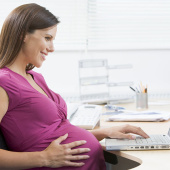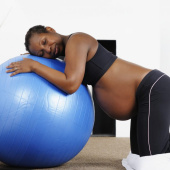There are lots of options to consider when choosing where to give birth, which can have an impact on your birth experience. Here's some information on those options...
Where and how you have your baby is a very personal choice. It’s a good idea to think about what you want well in advance of your due date.
There are various options, from hospitals to midwife-led units to home births. Some people feel most comfortable giving birth at home in familiar surroundings, while others prefer to know they are with or near doctors. Your needs, risk factors and what services are available where you live (NHS, 2018) are likely to influence your decision.
Where can I give birth?
In the UK, there are three main options for where to give birth:
- at home
- in a midwife-led unit or birth centre – a unit run by midwives
- in a hospital on the labour ward or in theatre
(NHS, 2018)
All of these planned places of birth can be discussed with your midwife but if an anaesthetic or surgery is required, then a hospital birth is the only option.
A planned birth at home
You may plan to give birth at home (NHS, 2018). Not all maternity care organisations are able to provide midwives to support homebirths, but your midwife will be able to give you up-to-date information about the services available where you live. You might like to take a look at our page about planning a home birth.
If your pregnancy is low risk and it’s not the first time you're giving birth, research shows that planned home birth is just as safe for your baby as a planned birth in hospital (NICE, 2017, Scarf et al, 2018; Homer et al, 2019; Hutton et al, 2019). If your pregnancy is low risk and this is your first birth, there is a small increase in risk for your baby (Hollowell et al, 2011).
With a planned home birth, there is still a chance of transferring to an obstetric unit during labour or afterwards. The chances of transfer are higher for first births (45%) than subsequent births (12%) (NPEU, 2017).
A planned birth at a midwife-led unit or birth centre
You can choose to give birth at a midwife-led unit, sometimes called birth centres. Midwife-led units can either be located alongside a hospital maternity unit or can be freestanding from the hospital. Midwife-led units are staffed by midwives and maternity support workers. Doctors are not available in midwife-led units, so you would need to be transferred to a hospital obstetric unit or labour ward if you or your baby need medical care.
Both types of midwife-led unit are designed to feel less clinical, with softer colours, lighting, and more home-like furnishings. Many also have additional active labour aids, such as birth balls, birth stools and birth pools.
If your pregnancy is low risk, a planned birth in either an alongside or freestanding midwife-led unit is associated with fewer interventions for women than a planned birth in a hospital obstetric unit, and is as safe for the baby as planned birth in a hospital obstetric unit (Birthplace in England Collaborative Group, 2011).
A planned birth in hospital
You may choose to give birth in hospital. Having the option of immediate access to medical support can be reassuring for some parents, especially if it is your first time.
If you have certain medical conditions, it might be recommended to have your baby in hospital. This is because hospitals have specialists who can help you if you need any treatment when you’re in labour (NHS, 2018).
Unless you have been advised to attend hospital early, it is beneficial to stay at home until labour is established. Do contact the hospital if you are concerned about yourself or your baby though. This can help to keep you comfortable, and research shows that going into hospital in early labour can increase the length of time you spend in hospital overall (Miller et al, 2020).
Transfers to hospital
Sometimes, a transfer from home, a freestanding midwife-led unit, or an alongside midwife-led unit to a hospital labour ward is needed after labour has started. Some transfers are made before the baby is born and some after. Transfers are more likely for first-time births (NICE, 2014).
At home and in freestanding or alongside birth centres, you won’t have access to immediate obstetric, neonatal or anaesthetic care (Birthplace in England Collaborative Group, 2011; NHS, 2018). So when you’re planning where to have your baby, a consideration might be your chances of being transferred to an obstetric unit during labour or after birth.
Most commonly, transfers are made because of slow or delayed progress in labour (Birthplace in England Collaborative Group, 2011). Some transfers are made because a woman decides that she wants to move, for a reason such as wanting different pain relief. Other transfers may be for the midwife to feel more supported with additional care in case a problem emerges, while more rarely some transfers are due to an actual problem during labour (NICE, 2014).
For first-time births, 36 in 100 of those planned at freestanding units are transferred, compared with 40 in 100 births for planned births in alongside midwife-led units. Second time or subsequent births have a 9 in 100 chance of transfer from freestanding midwife-led units, with 13 in 100 transferring from an alongside unit (NPEU, 2017).
How do I choose where to give birth?
You could research possible choices for where to give birth in your local area, to help you make an informed decision. There is a lot of evidence available to help you weigh up the advantages and disadvantages of giving birth at each location (NHS, 2018).
You can ask your midwife for information and discuss the options available to you in your area. It’s also good to get information from other sources, such as by attending an antenatal course, like our NCT Antenatal courses. Talking to other parents can be really helpful, too.
If you are considering a birth centre or hospital birth, you may be able to arrange a visit ahead of your expected due date or take a virtual tour online (Which?, 2018a). This can help to familiarise yourself with the location and facilities.
Other things to consider include the type of facilities available. For example, you might be considering a water birth in a birthing pool (Which?, 2018b). You can plan to have a birthing pool at home and they might be available at some birth suites and hospitals. It’s best to ask in advance about the type and number of birthing pools available.
Where you decide to give birth will depend on your wishes and any need for clinical support that you may have. Wherever you choose - hospital, midwife-led unit or home - the place should feel right for you (NHS, 2018).
What questions should I ask?
When discussing where to give birth, you might like to think about asking or researching the following:
- What pain relief options will be available to me during labour? You can check out your options in our articles about pain relief for home births, midwife-led units and hospitals.
- Will there be an option for having a water birth or using water for pain relief?
- Who will look after me during pregnancy and labour? Find out more in our articles about who looks after you at home, in a midwife-led unit and in hospital.
- How far would I have to travel when I’m in labour?
- Is it possible for me to access specialist medical care or facilities if I need them? You could take a look at our articles about what happens if you have complications at home, in a midwife-led unit or at hospital.
- What postnatal care services will be available to me?
(Which? 2018b)
Having done your research, you will hopefully feel more confident in your birth choices.
If you need to or want to change your mind about where to give birth, you can do this at any point in the pregnancy. You may find later on in the pregnancy, or even as your labour progresses, that your birth options or your choices change (NHS, 2018). Researching and understanding your options in advance will help you to feel confident in the decisions you are making for you and your baby.
Where can I find more information?
- Children’s centres
- Your GP surgery
- NHS postcode search which lists maternity services in your area (England only)
- Local maternity units
- Maternity Voice Partnerships (MVPs) – you need to ask your local hospital’s maternity unit
- The Birthplace Study
- Your family or friends
This page was last reviewed in August 2022.
Further information
Our support line offers practical and emotional support with feeding your baby and general enquiries for parents, members and volunteers: 0300 330 0700.
We also offer antenatal courses which are a great way to find out more about pregnancy, labour and life with a new baby.
Birthplace in England Collaborative Group (2011) ‘Perinatal and maternal outcomes by planned place of birth for healthy women with low risk pregnancies: the Birthplace in England national prospective cohort study’, BMJ, 343(nov23 4), pp. d7400–d7400. Available at: https://doi.org/10.1136/bmj.d7400
Homer C, Cheah S, Rossiter C, Dahlen H, Ellwood D, Foureur M, Forster D, McLachan H, Oats J, Sibbritt D, Thornton C, Scarf V. (2019) Maternal and perinatal outcomes by planned place of birth in Australia 2000 – 2012: a linked population data study. BMJ. Available from: https://bmjopen.bmj.com/content/bmjopen/9/10/e029192.full.pdf [Accessed 29th March 2021].
Hollowell J, Puddicome D, Rowe R, et al. (2011) The Birthplace national prospective cohort study: perinatal and maternal outcomes by planned place of birth in England research programme: final report. NIHR Service Delivery and Organisation programme. Available at: https://www.npeu.ox.ac.uk/birthplace (Accessed 21st May 2018)
Hutton E, Reitsma A, Simioni J, Brunton G, Kuafman K. (2019) Perinatal or neonatal mortality among women who intend at the onset of labour to give birth at home compared to women of low obstetrical risk who intend to give birth in hospital: A systematic review and meta-analyses. The Lancet. Available from https://www.thelancet.com/journals/eclinm/article/PIIS2589-5370(19)30119-1/fulltext [Accessed 29th March 2021].
Miller Y, Armanesco A, McCosker L, Thompson R. (2020) Variations in outcomes for women admitted to hospital in early versus active labour: an observational study. BMC Pregnancy and Childbirth. Available from https://bmcpregnancychildbirth.biomedcentral.com/articles/10.1186/s12884-020-03149-7 [Accessed 29th March 2021].
NFWI; NCT. (2013) Support overdue: women’s experiences of maternity services. Available from: https://www.nct.org.uk/sites/default/files/related_documents/Support%20Overdue%20Report.pdf [Accessed 29 March 2021]
NHS. (2018) Where to give birth: the options. Available at: https://www.nhs.uk/conditions/pregnancy-and-baby/where-can-i-give-birth/ [Accessed 29 March 2021]
NICE. (2014) Choosing place of birth : Resource for midwives. Available from: https://www.google.co.uk/url?sa=t&rct=j&q=&esrc=s&source=web&cd=&ved=2ahUKEwiA6qCDotXvAhWEoXEKHXM9BEwQFjAAegQIAhAD&url=https%3A%2F%2Fwww.nice.org.uk%2Fguidance%2Fcg190%2Fresources%2Fchoosing-place-of-birth-resource-for-midwives-msword-248730877&usg=AOvVaw2Zn9QlGQTjr5tGOSWyBryy [Accessed 29th March 2021].
NICE. (2017) Intrapartum care for healthy women and babies. Available from: https://www.nice.org.uk/guidance/cg190/chapter/Recommendations#place-of-birth [Accessed 29 March 2021]
NPEU. (2017) Birthplace in England Research Programme. Available from: https://www.npeu.ox.ac.uk/birthplace [Accessed 29 March 2021]
Scarf V, Rossiter C, Vedam S, Dahlen H, Ellwood D, Forster D, Foureur M, McLachan H, Oats F, Sibbritt D, Thornton C, Homer C. (2018) Maternal and perinatal outcomes by planned place of birth among women with low-risk pregnancies in high-income countries: A systematic review and meta-analysis. Midwifery. Available from https://www.sciencedirect.com/science/article/pii/S0266613818300974. [Accessed 29th March 2021].
Which? (2018a) Birth Choice. Visiting your local maternity unit – checklist. Available from: https://www.which.co.uk/birth-choice/choosing-where-to-give-birth/visiting-your-local-maternity-unit-checklist [Accessed 29 March 2021]
Which? (2018b) Birth Choice. Why choosing where to give birth matters. Available from: https://www.which.co.uk/birth-choice/choosing-where-to-give-birth/why-choosing-where-to-give-birth-matters [Accessed 29 March 2021]






